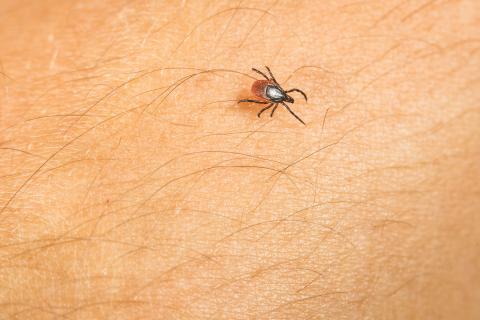About Anaplasmosis
Anaplasmosis is an illness spread by ticks. In Wisconsin, it is spread by the deer tick, also known as the black-legged tick.
Anaplasmosis is caused by the bacterium Anaplasma phagocytophilum.
Anyone can get anaplasmosis. People who spend more time outdoors are at a higher risk of being bitten by an infected tick.
Deer ticks are commonly found in areas with woods, brush, or tall grass. Deer ticks are most active from May to November in Wisconsin, but they can be active anytime temperatures are above 40°F.
Map description
The map to the right shows the annual average number of cases of anaplasmosis per 100,000 people by county.
More cases of anaplasmosis occur in the northern, western, and northeastern regions of the state.
The deer tick, which spreads anaplasmosis, is also more common in these regions.
Protect yourself with Tick Bite Prevention
Anaplasmosis 101
Anaplasmosis is spread to humans through the bite of an infected deer tick.
To prevent illness, it’s important to remove ticks as soon as you find them. A tick must be attached for at least 12–24 hours to spread anaplasmosis to a person.
Most people are infected by immature ticks, called nymphs. Nymphs are very small, about the size of a poppy seed. They’re hard to see. Most people don’t feel their bites. This makes them harder to remove right away. Nymphs are most active during the spring and early summer.
Adult ticks also spread anaplasmosis. Adults are larger than nymphs. They’re more likely to be found and removed before the bacteria spread to the person. The image to the right shows an adult deer tick. Adult ticks are most active during the cooler months in early spring and fall.
Ticks can attach to any part of the body. They often are found in hard-to-see areas, such as:
- Behind the knees.
- In the armpits.
- On the scalp.
- In and around the ears.
- Inside the belly button.
- On the groin.
Anaplasmosis is preventable and treatable. Learn about Tick Bite Prevention and how to properly remove a tick if you’re bitten.
Symptoms can show up between five days to two weeks after being bitten by an infected tick. Early signs and symptoms are usually mild. If antibiotic treatment is delayed, more severe symptoms can occur. It’s important to get treatment as soon as possible to avoid serious illness.
The following symptoms can be seen with anaplasmosis. However, few people will have all the symptoms listed. The combination of symptoms varies for each person.
Early signs and symptoms
- Fever
- Chills
- Severe headache
- Muscle aches
- Tiredness
- Nausea, vomiting, diarrhea
Late signs and symptoms
- Respiratory failure
- Bleeding
- Organ failure
- Death
Anaplasmosis can be treated with antibiotics. Doxycycline is the most effective antibiotic for adults and children of all ages. Treatment should begin as soon as the doctor suspects you have anaplasmosis. Most people treated with oral antibiotics during the early stages of anaplasmosis fully recover.
It’s important to get treatment as soon as possible after symptoms start. Delaying treatment can be dangerous.
Antibiotic treatment following a tick bite (also called tick bite prophylaxis) isn’t recommended to prevent anaplasmosis. There is no evidence this practice is effective. It may only delay onset of the disease. Instead, if you’re bitten by a tick, be alert for the symptoms listed above. Call a doctor if you develop a fever or other symptoms.
Resources from the Wisconsin Department of Health Services
- Signs and symptoms, treatment, and prevention—Anaplasmosis and Ehrlichiosis Fact Sheet, P-42045
- Education on the risk posed by illnesses spread by ticks—Tickborne Diseases Risk in Wisconsin, P-01751 (PDF)
- Educational tri-fold card about Wisconsin, proper tick removal, and tick bite prevention—Tick Safety Guide Tri-Fold Card, P-01434 (PDF)
- Fact sheet with simple steps to take—Protecting Your Family From Mosquitoes and Ticks, P-02080 (PDF)
Resources from the CDC
- Signs and symptoms, treatment, prevention, and more—About Anaplasmosis
- Preventing Ticks on Your Pets
- Fact sheet on tick bite prevention for hunters—It's Open Season on Ticks (PDF)
- Plastic trail sign used to remind hikers that there are ticks in the area—Prevent Tick Bites (PDF).
- Fact sheet on steps to take after a tick bite—Tick Bite: What to Do (PDF)
- Educational comic for kids—Don't Let a Tick Make You Sick Comic (PDF)
- Educational crossword for kids—Don't Let a Tick Make You Sick Crossword (PDF)
Partner resources
- Information from the University of Wisconsin-Madison Medical Entomology Laboratory—Wisconsin Ticks and Tick-borne Diseases
- Information on ticks found in the Midwest, surveillance resources, and tick biology and development from the Midwest Center of Excellence for Vector-Borne Diseases—Ticks.
Contact us
Questions about illnesses spread by ticks? We’re here to help.
Bureau of Communicable Diseases
Phone: 608-267-9003
Fax: 608-261-4976



